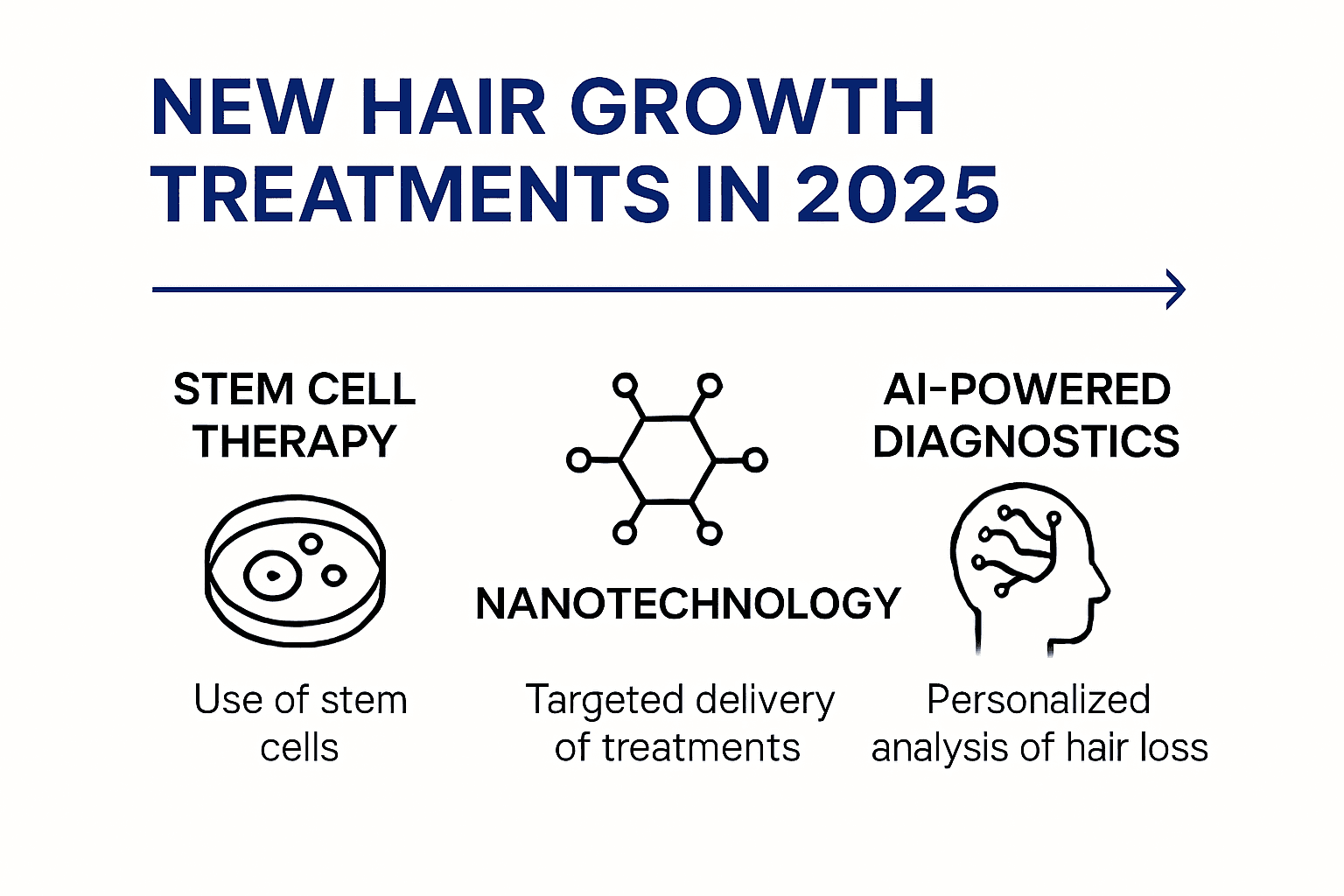Blog
Learning Materials
Best New Hair Growth Treatment Options in 2025
Updated: July 10, 2025

Hair loss solutions in 2025 have entered a whole new league. Scientists triggered hair growth in mice in just 10 days by boosting a single microRNA. Sounds like science fiction, right? The real twist is that these breakthroughs are no longer just for labs—AI tools and personalized cell therapies are turning hair regrowth into a science anyone can benefit from.
Table of Contents
- Latest Advances In New Hair Growth Treatment
- How MicroRNA And Innovative Drugs Boost Hair Growth
- Personalized Hair Growth Tracking And Care Solutions
- Choosing The Right Hair Growth Treatment For You
Quick Summary
| Takeaway | Explanation |
|---|---|
| Stem Cell Regeneration Techniques | Advances in understanding the role of stem cells in hair growth are paving the way for treatments that target the root causes of hair loss rather than just managing symptoms. |
| MicroRNA Breakthroughs | Manipulating microRNA, specifically miR-205, provides new methods for hair growth stimulation, offering a genetic approach to hair restoration that could enhance treatment efficacy. |
| AI and Personalized Diagnostics | The integration of AI in hair loss diagnostics allows for highly personalized treatment plans, improving outcomes based on individual health patterns and hair loss profiles. |
| Emerging Treatment Options | Innovations like stem cell therapy, exosome therapy, and low-level laser therapy present advanced, personalized options for hair restoration, adapting to unique hair loss causes and conditions. |
| Consult Healthcare Professionals | Collaborating with healthcare professionals is critical for selecting the most appropriate hair growth treatment that is tailored to personal medical history and specific hair loss needs. |
Latest Advances in New Hair Growth Treatment
The landscape of hair growth treatments is experiencing a revolutionary transformation in 2025, driven by groundbreaking scientific discoveries and innovative technological approaches. Medical researchers are now exploring unprecedented strategies to address hair loss and stimulate natural hair regeneration.
Stem Cell Regeneration Techniques
One of the most promising developments in new hair growth treatment comes from cellular research. Researchers at the University of Virginia have made a critical breakthrough by identifying the precise role of stem cells in hair follicle regeneration. Their research reveals that specific stem cells located in the upper and middle sections of hair follicles are fundamental to hair growth mechanisms.
The implications of this discovery are profound. By understanding how to activate and replenish these critical stem cells, scientists are developing targeted interventions that could potentially reverse hair loss at its cellular origin. This approach represents a significant shift from traditional treatments that merely managed symptoms to a more sophisticated strategy targeting the root cause of hair loss.

Advanced Biotechnology and Nanotechnology
Cutting edge biotechnology is revolutionizing hair growth treatments through innovative delivery mechanisms. A comprehensive study published in Pharmaceutics highlights the transformative potential of nanocarriers and 3D bioprinting technologies. These advanced techniques enable more precise and effective drug delivery directly to hair follicles, dramatically improving treatment efficacy.
Nanocarriers represent a particularly exciting development. These microscopic vehicles can transport growth-stimulating compounds directly to hair follicle cells, ensuring maximum absorption and minimizing potential side effects. By encapsulating active ingredients in nano-sized particles, researchers can create more targeted and efficient hair regeneration strategies.
Computational Drug Discovery
The integration of artificial intelligence and computational biology is opening new frontiers in hair loss treatment. Research published in Frontiers in Bioinformatics demonstrates how computational methods can identify potential 5α-reductase inhibitors from phytochemicals. This approach allows scientists to screen thousands of compounds rapidly, identifying those with the highest potential for promoting hair growth.
These computational techniques represent a significant advancement over traditional trial and error methods. By leveraging machine learning algorithms, researchers can predict molecular interactions and potential therapeutic compounds with unprecedented accuracy. For individuals struggling with hair loss, this means more personalized and effective treatment options are on the horizon.
For more comprehensive insights into enhancing hair volume, check out our guide on achieving thicker hair, which complements these cutting-edge research developments.

As scientific understanding continues to evolve, these emerging technologies promise not just to manage hair loss but to fundamentally transform our approach to hair restoration. The future of hair growth treatment is here, offering hope and tangible solutions for individuals experiencing hair thinning or loss.
How MicroRNA and Innovative Drugs Boost Hair Growth
The frontier of hair growth treatment is experiencing a remarkable transformation through groundbreaking molecular and pharmaceutical innovations. Emerging research reveals that microRNA and targeted drug therapies are revolutionizing our understanding of hair regeneration at the cellular level.
MicroRNA: The Genetic Trigger for Hair Growth
Researchers at Northwestern University have uncovered a remarkable breakthrough in hair growth mechanisms by focusing on microRNA-205 (miR-205). Their research demonstrates that increasing miR-205 production in hair follicle stem cells can trigger hair growth in both young and old mice within just 10 days. This discovery represents a significant leap forward in understanding the genetic switches that control hair regeneration.
The study reveals that miR-205 works by softening hair follicle stem cells, creating a more conducive environment for hair growth. This molecular approach offers a precision targeting method that goes beyond traditional topical treatments, addressing hair loss at its genetic roots. By manipulating these microscopic genetic regulators, scientists are developing more effective and personalized hair restoration strategies.
Advanced Pharmaceutical Interventions
A groundbreaking FDA approval in July 2024 marked a significant milestone in hair loss treatment. Deuruxolitinib, a Janus kinase (JAK) inhibitor selective for JAK1 and JAK2, became a new therapeutic option for severe alopecia areata. This targeted drug approach represents a sophisticated method of addressing hair loss by interrupting specific cellular signaling pathways that contribute to hair follicle dysfunction.
Further expanding the pharmaceutical landscape, research from North Carolina State University identified microRNA-218-5p (miR-218-5p) as a critical regulator in hair follicle regeneration. Their studies showed that enhancing miR-218-5p levels in dermal papilla cells can promote hair growth, while its inhibition leads to follicle dysfunction. This research provides insight into the complex molecular mechanisms that control hair growth and offers potential new therapeutic targets.
Personalized Molecular Hair Restoration
The convergence of microRNA research and targeted drug therapies is creating a new paradigm in hair restoration. These approaches move beyond one-size-fits-all solutions, offering personalized treatments that address individual genetic and cellular variations. By understanding the specific molecular triggers that control hair growth, researchers can develop more precise and effective interventions.
Learn more about personalized hair care strategies that complement these cutting-edge molecular approaches. The future of hair growth treatment is no longer about managing symptoms but about understanding and manipulating the fundamental biological processes that control hair regeneration.
As scientific understanding continues to advance, these innovative approaches promise more effective, personalized, and targeted solutions for individuals experiencing hair loss. The combination of microRNA research and sophisticated pharmaceutical interventions is transforming hair restoration from a hopeful dream to a scientific reality.
Personalized Hair Growth Tracking and Care Solutions
The era of one-size-fits-all hair care is rapidly evolving into a sophisticated landscape of personalized solutions driven by advanced technology and precision diagnostics. In 2025, individuals experiencing hair loss now have access to unprecedented tools that offer detailed insights and tailored treatment strategies.
AI-Powered Diagnostic Technologies
A groundbreaking clinical trial published in 2025 demonstrated the remarkable potential of AI-driven platforms in delivering personalized hair loss treatments. The study revealed significant improvements in hair growth, coverage, and thickness over a 24-week period, with no adverse events reported. This breakthrough highlights the transformative power of artificial intelligence in understanding individual hair health patterns.
Researchers developing ScalpVision, an advanced AI-driven diagnostic system, have enhanced the ability to diagnose scalp diseases and alopecia. By utilizing innovative techniques like label-free segmentation and training-free image translation, the system effectively addresses challenges such as data imbalance and expensive labeling processes. This technological advancement means more accurate and personalized hair loss assessments are now possible.
Robotic Assistance in Hair Care
The integration of robotics into personal hair care represents another frontier of personalized solutions. Researchers introducing MOE-Hair, a soft robotics system, have demonstrated the potential for robotic assistance in hair care tasks. This compliant robot can perform intricate actions like head patting, finger combing, and hair grasping, suggesting a future where technological precision meets personal grooming.
These robotic technologies are not intended to replace human care but to provide supplementary support. They offer consistent, gentle handling that can be particularly beneficial for individuals with sensitive scalps or those requiring specialized hair management techniques. The precision of robotic systems could revolutionize how we approach daily hair care routines.
Comprehensive Personalized Hair Growth Strategies
The convergence of AI diagnostics, robotic technologies, and advanced tracking systems is creating a holistic approach to hair health. Users can now access detailed insights into their scalp condition, hair growth patterns, and potential risk factors. Learn more about optimizing your hair care routine and how these emerging technologies can support your individual needs.
These personalized solutions go beyond traditional treatments by offering real-time monitoring, predictive analysis, and customized intervention strategies. Machine learning algorithms can now analyze multiple data points including genetic predisposition, environmental factors, nutritional intake, and stress levels to create comprehensive hair growth management plans.
As technology continues to advance, the future of hair care is becoming increasingly individualized. What once seemed like science fiction is now a tangible reality, providing hope and practical solutions for those struggling with hair loss. The combination of advanced diagnostics, AI-driven insights, and precision technologies promises a new era of personalized hair health management.
Choosing the Right Hair Growth Treatment for You
Selecting the most appropriate hair growth treatment requires a nuanced understanding of individual hair loss patterns, underlying health conditions, and personal treatment goals. In 2025, individuals have access to an unprecedented range of sophisticated and targeted hair restoration options.
Understanding Your Hair Loss Profile
Identifying the specific type and cause of hair loss is crucial for selecting an effective treatment. Research from the National Institutes of Health emphasizes the importance of comprehensive diagnostic assessments before initiating any hair restoration strategy. Different hair loss types demand distinct approaches, whether addressing genetic factors, hormonal imbalances, or underlying medical conditions.
The diagnostic process now involves advanced technologies that analyze scalp health, genetic predispositions, and individual hair follicle characteristics. These detailed assessments provide a roadmap for personalized treatment, moving beyond generic solutions to targeted interventions that address the root cause of hair loss.
Emerging Treatment Options
Stem cell therapy represents a groundbreaking approach to hair restoration. By utilizing autologous dermal sheath cup cells (DSCs), this innovative treatment involves culturing a patient's own cells and strategically reintroducing them to stimulate hair follicle regeneration. Unlike traditional methods, this approach offers a highly personalized solution that works with the body's natural healing mechanisms.
Exosome therapy presents another cutting-edge option. These nanoscale vesicles play a crucial role in intercellular communication, demonstrating potential to affect hair follicle cell function, including proliferation and differentiation. Low-Level Laser Therapy (LLLT) provides a non-invasive alternative, using specific light wavelengths to stimulate hair follicles and promote growth.
Personalized Treatment Selection
Choosing the right treatment involves careful consideration of multiple factors. Explore our comprehensive guide to achieving thicker hair to understand the nuanced approach to hair restoration. Key considerations include:
- Personal medical history
- Extent and type of hair loss
- Age and overall health condition
- Budget and treatment accessibility
- Potential side effects and long-term outcomes
Consultation with healthcare professionals remains paramount. They can provide personalized recommendations based on a holistic assessment of your unique hair loss profile. Modern diagnostic technologies now enable more precise treatment recommendations, reducing the trial-and-error approach of previous years.
The landscape of hair growth treatments continues to evolve rapidly. What was considered impossible a decade ago is now a realistic option for many individuals experiencing hair loss. From advanced cellular therapies to precision diagnostic tools, the future of hair restoration is increasingly personalized, effective, and tailored to individual needs.
Remember that successful hair growth treatment is not just about selecting a method but understanding your body's unique characteristics and working with healthcare professionals to develop a comprehensive, long-term strategy.
To help clarify and compare some of the emerging hair growth therapies discussed, here is a summary table highlighting their mechanisms, personalization, and advantages.
| Treatment Approach | Main Mechanism | Personalization Type | Key Advantages |
|---|---|---|---|
| Stem Cell Therapy | Activates/regenerates hair follicle stem cells | Patient-derived cells | Treats root cause, highly targeted |
| Exosome Therapy | Delivers nanoscale vesicles for cell communication | Biologically tailored | Promotes cell function, less invasive |
| MicroRNA-based Treatments | Modulates genetic triggers (e.g., miR-205, miR-218-5p) | Genetic/molecular profile | Fast results, addresses genetic regulation |
| JAK Inhibitors (e.g., Deuruxolitinib) | Inhibits Janus kinase pathways in follicles | Drug dosage/selection | FDA-approved, rapid impact for alopecia areata |
| Nanocarrier Drug Delivery | Directs active ingredients precisely to follicles | Targeted to follicle location | Minimizes side effects, maximizes absorption |
| Low-Level Laser Therapy | Stimulates follicles via light wavelength | Intensity/frequency tailored | Non-invasive, promotes growth safely |
| AI-Personalized Diagnostics | AI analyzes patterns for custom regimens | Algorithm-based personalization | Greater accuracy, outcome tracking, adaptive strategies |
Additionally, below is a decision checklist table to help readers evaluate important considerations before choosing a hair growth treatment.
| Consideration | Why It Matters | Have You Reviewed This? |
|---|---|---|
| Medical History | Impacts risk and eligibility for some therapies | [ ] |
| Type/Extent of Hair Loss | Determines which therapies may be effective | [ ] |
| Budget/Accessibility | Some advanced treatments are higher cost or limited access | [ ] |
| Willingness for Personalized Care | Influences treatment approach and ongoing monitoring | [ ] |
| Tolerance for Potential Risks | All therapies carry some risk/side effects | [ ] |
| Consultation with a Professional | Ensures proper diagnosis and optimal selection | [ ] |
Frequently Asked Questions
What are the latest advances in hair growth treatments for 2025?
In 2025, hair growth treatments include stem cell regeneration techniques, advanced biotechnology, and AI-driven diagnostics that personalize treatment plans for more effective results.
How does microRNA influence hair growth?
MicroRNA, especially miR-205, plays a crucial role in activating hair follicle stem cells, leading to accelerated hair growth and providing a genetic basis for new hair restoration methods.
What personalized options are available for hair growth tracking?
Personalized options for hair growth tracking include AI-powered diagnostic tools and robotic assistance that provide tailored insights and interventions based on individual hair loss profiles.
How can I choose the right hair growth treatment for my needs?
To choose the right treatment, assess your hair loss profile, consider emerging treatments like stem cell therapy or exosome therapy, and consult with healthcare professionals to develop a personalized plan.
Ready for Real Change in Your Hair Growth Journey?
Are you frustrated with outdated hair loss remedies or generic solutions that never seem to work for you? The "Best New Hair Growth Treatment Options in 2025" article explores how cutting-edge breakthroughs like AI diagnostics, microRNA therapies, and stem cell solutions can finally address the root causes of thinning hair. But making sense of all these promising options can be overwhelming. If you want results tailored to your unique hair story, you need more than just the latest science. You need technology that understands you.

Let MyHair.ai take the guesswork out of your search. Upload your hair scans and get personalized, AI-driven insights that align with the newest research. Track your progress over time, receive product recommendations chosen just for your needs, and take advantage of the latest in hair health monitoring. Start your transformation today with a free hair health assessment at MyHair.ai or explore actionable routines in our guide to achieving thicker hair. Don’t wait—advanced hair growth solutions are now within your reach.